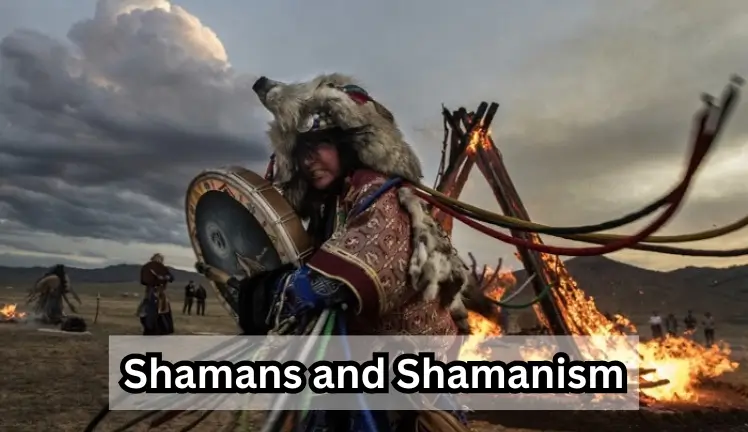Introduction: Who Are Shamans?
Shamans and Shamanism: Shamans are spiritual healers, guides, and mediators between the human world and the spirit realm. Rooted in ancient cultures, shamanism is a global tradition found among Indigenous tribes of Siberia, the Americas, Africa, and Asia. A shaman is not just a medicine man but a bridge between the physical and metaphysical, accessing hidden knowledge for healing, guidance, and protection.

The Origins of Shamanism
The word shaman originates from the Tungusic language of Siberia and means “one who knows.” Archaeological evidence suggests that shamanic practices may be over 30,000 years old, evolving long before organized religion. Cave paintings, burial sites, and ceremonial artifacts across continents hint at shamanic roots in early human spirituality.
Shamanism likely developed as a survival tool—explaining disease, death, and natural forces through spiritual frameworks.
Core Beliefs in Shamanism
Despite regional variations, most shamanic traditions share these core beliefs:
- Animism: All entities—animals, plants, rocks, rivers—have spirits.
- The Spirit World: A separate, non-physical realm that shamans can access.
- Illness as Imbalance: Disease is often seen as spiritual disharmony.
- Healing Through Journeying: Shamans travel in trance states to retrieve lost souls or gain insight.
Shamans work to restore harmony between individuals and nature, people and spirits, the body and the soul.
The Role of a Shaman
Shamans fulfill diverse roles within their communities. Their responsibilities include:
- Healing: Using herbs, energy, and rituals to cure physical and mental ailments.
- Divination: Interpreting visions, omens, and dreams to guide decisions.
- Spiritual Protection: Warding off evil spirits or removing curses.
- Soul Retrieval: Recovering fragmented parts of the soul after trauma or loss.
- Conducting Rituals: For births, deaths, marriages, or seasonal transitions.
A shaman’s tools may include drums, rattles, feathers, bones, animal skins, and sacred plants like ayahuasca or peyote, depending on tradition.
The Shamanic Journey
One of the most defining elements of shamanism is the shamanic journey—a trance-like state that allows the shaman to enter the spiritual dimension. This can be induced by:
- Rhythmic drumming or chanting
- Dancing
- Fasting or sensory deprivation
- Plant-based entheogens (psychedelics)
During this journey, the shaman seeks guidance from spirit allies—animals, ancestors, or celestial beings—and brings back knowledge or healing.
Shamanism Across Cultures
Though the name “shaman” comes from Siberia, shamanism is global in scope:
- Siberia: Origin of the term; shamans often work with animal spirits.
- Native American Tribes: Medicine men and women engage in sweat lodges and vision quests.
- Amazonian Tribes: Ayahuasca ceremonies guided by shamans are integral to healing.
- Africa: Sangomas and diviners use ancestral spirits and bone casting.
- Mongolia: Shamans serve as protectors and seers with deep ties to nature.
- Korea & Japan: Female shamans conduct ancestor rituals and exorcisms.
Each culture interprets shamanism uniquely, yet all emphasize spiritual connectedness and ritualistic healing.
Shamanism and Modern Science
While some view shamanism as superstition, others recognize its psychological and therapeutic value. Modern psychology increasingly explores shamanic techniques like soul retrieval and trance work as tools for trauma healing.
- Carl Jung likened shamans to early psychologists working with the collective unconscious.
- Transpersonal Psychology embraces shamanic journeying for inner growth.
- Psychedelic Therapy has revived interest in ayahuasca, psilocybin, and other plant medicines used in traditional shamanic contexts.
Today, shamanic principles are even woven into wellness trends like energy healing, ecotherapy, and mindfulness.
Becoming a Shaman: A Calling, Not a Career
Unlike professions chosen voluntarily, becoming a shaman is typically a spiritual calling, often marked by:
- A near-death experience or serious illness
- Prophetic dreams or visions
- Inheritance through family lineage
- Acceptance by a tribal elder or spiritual guide
Training can take years and often includes apprenticeship, learning to diagnose spiritual illness, and mastering rituals.
Shamanism in the 21st Century
Far from extinct, shamanism is experiencing a revival in both Indigenous and urban settings:
- Neo-shamanism blends traditional practices with modern spirituality.
- Online courses and workshops offer shamanic teachings globally.
- Shamanic retreats attract seekers looking for transformation and healing.
However, this renaissance raises questions of cultural appropriation. True shamanism is deeply rooted in specific cultures and must be approached with reverence and respect.
Ethical Concerns: Respect vs. Appropriation
As shamanic practices become popular in the West, there’s growing criticism about:
- Commercialization of sacred traditions
- Unqualified individuals claiming to be shamans
- Exploitation of Indigenous knowledge without consent or benefit
It’s essential to differentiate between authentic, lineage-based practice and superficial adaptations.
Conclusion: A Timeless Spiritual Bridge
Shamanism continues to thrive because it meets a universal human need—connection to something greater than the self. Whether through healing, guidance, or spiritual insight, shamans offer a model for holistic well-being that honors both the physical and metaphysical.
In an age of digital overload and disconnection, the ancient wisdom of the shaman remains more relevant than ever.
FAQs
What is the purpose of a shaman?
A shaman serves as a healer and spiritual guide, helping individuals and communities connect with the spirit world for healing, insight, and protection.
Are shamans only found in Indigenous cultures?
While shamanism originated in Indigenous cultures, its principles are now explored globally in various spiritual and therapeutic contexts.
Is shamanism a religion?
Shamanism is more of a spiritual practice than a formal religion. It lacks scriptures or clergy but emphasizes ritual, nature, and spirit communication.
Can anyone become a shaman?
Traditionally, one becomes a shaman through a spiritual calling or initiation, not by choice. However, modern adaptations allow interested individuals to study its practices respectfully.
Are psychedelic substances necessary for shamanic journeying?
No. Many shamans use drumming, chanting, or meditation instead of plant medicine. Psychedelics are one of several tools, not a requirement.